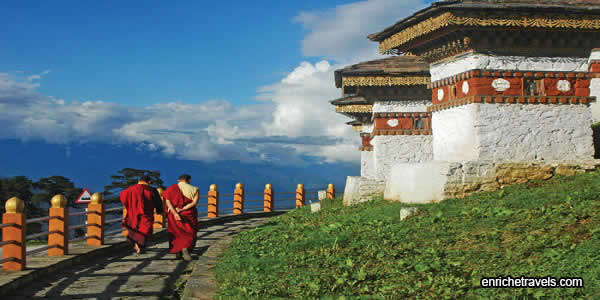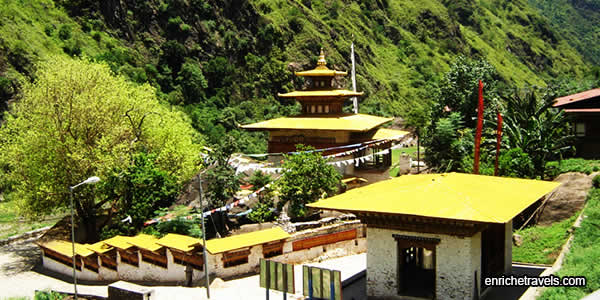Description
Places Covered : Paro – Thimpu – Punakha – Bhumthang – Punakha – Paro
HIGHLIGHTS:
* Gross National Happiness is deemed more important than Gross National Product.
* Amazing mountainous landscaping
* Snowcapped peaks
* Rise out of forests in every shade of green.
* Fantastic monasteries and incredible fortresses like dzongs
* The unique Buddhist architecture embodies the traditional Buddhist culture and sets the scene for spectacular religious dance festivals.
* Then there are textiles, handicrafts, archery competitions, amazing trekking trails and breath taking flora and fauna.
Package Details
Day 1
Arrival at Paro and transfer to Thimpu
Fly into Paro by Druk Air, Royal Bhutan Airlines. The great snowcapped peaks of the inner Himalayas rise up to the heavens can be seen during clear weather. As the plane approaches Bhutan, if you look down farmhouses as dots on the hillsides can be seen. As the aircraft enters the Paro valley, you will see Paro Dzong on the hillside overlooking the Paro Chu (river), with Ta Dzong, formerly a watchtower and now the National Museum, above it. On arrival at Paro international airport,you will be received by our representatives and be droven to Thimphu. O/N at Thimphu.
Day 2
Thimpu
We will start our day with the visit to:
- National Memorial Chorten: This is continuously circumambulated by the faithful, murmuring mantras and spinning their prayer wheels.
- Buddha Point: One of the biggest Buddha in the world. It was constructed through donations from devotees all around the world.
- Painting school: It’s a non profitable organization established by government to encourage the youth into the unique arts and crafts.
- Folk Heritage Museum: It is one of the oldest traditional houses. This house has been around 150 years old. The Folk Heritage Museum with a three storied, 19th century traditional house provides you a glimpse of the Bhutanese lifestyle, and artifacts from the rural households.
- National Textile Museum: National Textile Museum which was opened in June 2001 is worth a leisurely visit to get to know the living of national art of weaving.
- Tashichodzong: The beautiful medieval fortress/monastery which houses most of the government’s office and King’s Throne room.
O/N at Thimphu.
Thimpu-Punakha
After breakfast drive to Punakha with a stop at Dochula pass (3080m). Here we can view and admire the Chorten, Mani wall, and prayer flags which decorates the highest point on the road.
If the sky is clear, the following peaks can be visible from this pass(left to right): Masagang(7,158m),Tshendagang(6,960m),Terigang(7,060m),
Jejegangphugang(7,158m),Kangphugang(7,170m),Zongphugang(7,060m),a table mountain dominates the isolated region of Lunana- finally Gangkar Puensum, the highest peak in Bhutan at 7,497m. We will have lunch on the way. After that we will visit to Chimi Lhakhang which is a short hike. Chimi Lhakhang Temples lies in the fertile Lobesa village of Punakha Valley. The temple is dedicated to the divine madman-Saint Drukpa Kuenley and the temple is also known as the Temple of Fertility. Check in at hotel. O/N at Punakha.
Punakha-Bhumtang
After breakfast drive to Bumthang. On the way visit Trongsa dzong, this is the most impressive Dzong (fort-monastery) in the kingdom, and can be seen from a great distance in its strategic position high above the Mangde Chhu. It is one of the most aesthetic and magnificent works of traditional Bhutanese architecture, a rambling collection of buildings trailing down the ridge. It has a succession of beautiful courtyards. Before reaching Bumthang we will visit Chumey valley which is now a days a popular tourist stop to see Yathra weaving (deep colored wool textile). You can see the weavers at work here and shop for textiles. O/N at Bhumthang.
Bhumtang-Punakha
After the sumptuous breakfast will move out for sightseeing which includes:
- Jambay Lhakhang built in the 7th century by the King Songtsen Goempo of Tibet. In his effort to propagate Buddhism he had a plan to build a total of 108 temples in Tibet and neighboring kingdoms.
- Kujey Lhakhang (Kujey means, “Body imprint”). The temple to the right is the oldest and was built by Minjur Tempa in 1652. It was built around the cave in which Guru Rinpoche meditated and left His body imprints.
- Jakar Dzong: “castle of the white bird”. According to legend, when the lamas assembled in about 1549 to select a site for a monastery, a big white bird rose flew suddenly in the air and settled on a spur of a hill. This was interpreted as an important omen, and the hill was chosen as the site for a monastery and for Jakar Dzong. The fortress is now used as an administrative center of the valley and summer residence of Trongsa monks. In the evening stroll around the beautiful landscape of the Bumthang Jakar valley.
Drive back to Punakha (approx.212km.) O/N at Punakha.
Punakha-Paro
Early morning we will visit to Punakha dzong. It is situated near two rivers– the Pho Chu (Male River) and Mo Chu (Female River.) Asia has a rich tradition of river personification. Punakha Dzong is one of the largest Dzong in Bhutan. Take the suspension bridge to arrive at the Dzong. Punakha Dzong was initially called Druk Pungthang Dechen Phodrang (Palace of Great Happiness), for many years until the second king of Bhutan assumed power. Punakha Dzong happened to be the seat of the Government for a long time. Lunch will be on the way. Then proceed to Paro. O/N at Paro.
Paro
In the morning we will visit: National Museum, Paro Dzong. After lunch we will visit: Kyichu Lhakhang, Drukgyel dzong. Evening free for leisure. O/N at paro.
Punakha-Paro
Today after the leisurely breakfast we will proceed for an excursion to the famous place called Taktshang Monastery (4hrs hike) Taktshang Monastery (Tiger Nest) is located at top of about 800 meter cliff in Paro. It takes slightly more than an hour and a half to reach the monastery on foot from the nearest road point. Taktshang or the Tigers lair as the monastery is widely regarded is one of the most important in Bhutan. Its history is associated with the visit of Guru Padmasambhava, the Indian saint who came to Bhutan in the 8th century AD. The cave was named Taktshang after Guru Rinpoche flew into the cave from Kurtoe Singye Dzong in eastern Bhutan riding on a tigress. Later in 1692 the fourth Druk Desi Tenzin Rabgye started to construct monastery and finally completed after three years in 1694. “Trip to Bhutan is never complete without climbing to Taktshang”, says one tourist. Indeed it’s true as the journey there fills you with spiritual bliss. O/N at Paro.
Departure
Like all good things, your Bhutan tour will come to an end. We will be happy to see you back. Our representative will help you with your exit formalities and drop you at Paro airport and bid you farewell.













Reviews
There are no reviews yet.